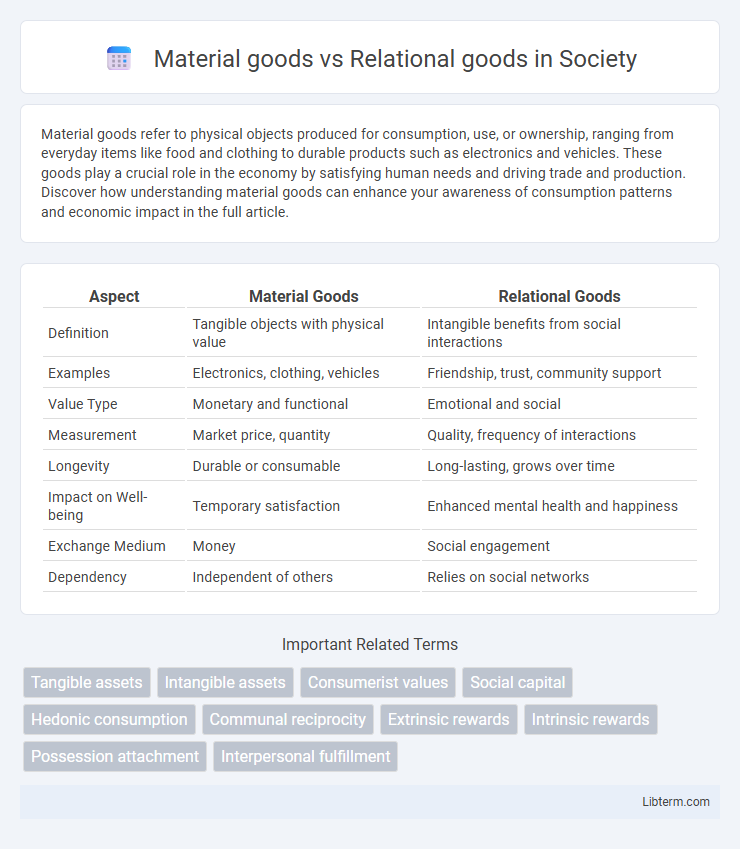Material goods refer to physical objects produced for consumption, use, or ownership, ranging from everyday items like food and clothing to durable products such as electronics and vehicles. These goods play a crucial role in the economy by satisfying human needs and driving trade and production. Discover how understanding material goods can enhance your awareness of consumption patterns and economic impact in the full article.
Table of Comparison
| Aspect | Material Goods | Relational Goods |
|---|---|---|
| Definition | Tangible objects with physical value | Intangible benefits from social interactions |
| Examples | Electronics, clothing, vehicles | Friendship, trust, community support |
| Value Type | Monetary and functional | Emotional and social |
| Measurement | Market price, quantity | Quality, frequency of interactions |
| Longevity | Durable or consumable | Long-lasting, grows over time |
| Impact on Well-being | Temporary satisfaction | Enhanced mental health and happiness |
| Exchange Medium | Money | Social engagement |
| Dependency | Independent of others | Relies on social networks |
Understanding Material Goods: Definition and Examples
Material goods refer to tangible objects that satisfy human wants and needs, such as clothing, electronics, and vehicles. These goods are physical items produced or manufactured for consumption and can be owned, exchanged, or stored. Examples of material goods include smartphones, furniture, and groceries, which provide direct utility and economic value.
What Are Relational Goods? Key Concepts Explained
Relational goods are intangible benefits derived from social interactions and relationships, such as trust, empathy, and shared experiences, which contribute significantly to well-being and life satisfaction. Unlike material goods, which are physical items like cars or gadgets, relational goods cannot be bought or sold but require active participation and mutual cooperation. Key concepts of relational goods emphasize their role in fostering social bonds, enhancing emotional support, and creating a sense of community and belonging.
The Psychological Impact of Material Possessions
Material possessions often provide temporary satisfaction but can lead to increased stress and consumer dissatisfaction when used as a primary source of happiness. Psychological studies reveal that low relational goods--such as meaningful social connections--coupled with high material consumption contribute to decreased well-being and increased feelings of loneliness. Prioritizing relational goods over material goods enhances long-term emotional resilience and life satisfaction.
Social Connections: The Value of Relational Goods
Relational goods refer to the intangible benefits derived from social connections and interactions, enriching well-being beyond material possessions. Unlike material goods, which satisfy physical needs, relational goods foster trust, cooperation, and emotional support, contributing to mental health and community cohesion. Research shows strong social bonds increase happiness and life satisfaction by fulfilling human needs for belonging and social validation.
Comparing Satisfaction: Material vs Relational Goods
Relational goods generate higher and more lasting satisfaction compared to material goods due to their foundation in social interactions and emotional connections. Studies show that experiences involving relationships, such as time spent with family and friends, enhance well-being and life satisfaction more effectively than acquiring physical possessions. Unlike material goods, whose happiness impact diminishes over time through adaptation, relational goods promote sustained fulfillment by fostering meaningful bonds.
Economic Perspectives on Goods: Material and Relational
Material goods are tangible products such as clothing, electronics, and food, which are typically exchanged in markets based on price and quantity. Relational goods, including social interactions, trust, and community engagement, derive value from human connections and cannot be easily quantified or traded. Economic perspectives emphasize that while material goods contribute to individual utility through consumption, relational goods enhance well-being by fostering social capital and collective cohesion, challenging traditional market-based valuation.
How Materialism Influences Well-Being
Materialism often leads to a pursuit of material goods such as money, possessions, and physical assets, which can provide temporary satisfaction but rarely contribute to long-term well-being or happiness. In contrast, relational goods -- including social connections, meaningful relationships, and community involvement -- have been shown to enhance emotional health and life satisfaction significantly. Research highlights that prioritizing materialism correlates with decreased overall well-being, increased stress, and lower life fulfillment compared to valuing relational goods.
The Role of Community in Generating Relational Goods
Communities foster relational goods by creating networks of trust, cooperation, and shared experiences that material goods alone cannot provide. Social interactions within communities enhance emotional well-being, collective identity, and social support, which are essential components of relational goods. The strength and quality of community ties directly influence the generation of relational goods, highlighting the importance of social cohesion over mere material wealth.
Consumer Culture and the Pursuit of Happiness
Consumer culture often emphasizes material goods as symbols of success and sources of happiness, yet research shows that relational goods--such as friendships and family connections--contribute more significantly to long-term well-being. Studies indicate that while acquiring possessions can provide temporary satisfaction, the quality and depth of social relationships foster enduring happiness and life satisfaction. Economic models increasingly recognize that investment in relational goods yields higher returns in overall life fulfillment compared to material consumption.
Building a Balanced Life: Integrating Both Goods
Balancing material goods and relational goods is essential for a fulfilling and sustainable life, as material goods provide comfort and security while relational goods foster emotional well-being and social connection. Prioritizing time for meaningful interactions alongside responsible consumption enhances overall happiness and resilience. Integrating both goods promotes holistic development, ensuring that financial success does not come at the expense of personal relationships and vice versa.
Material goods Infographic

 libterm.com
libterm.com